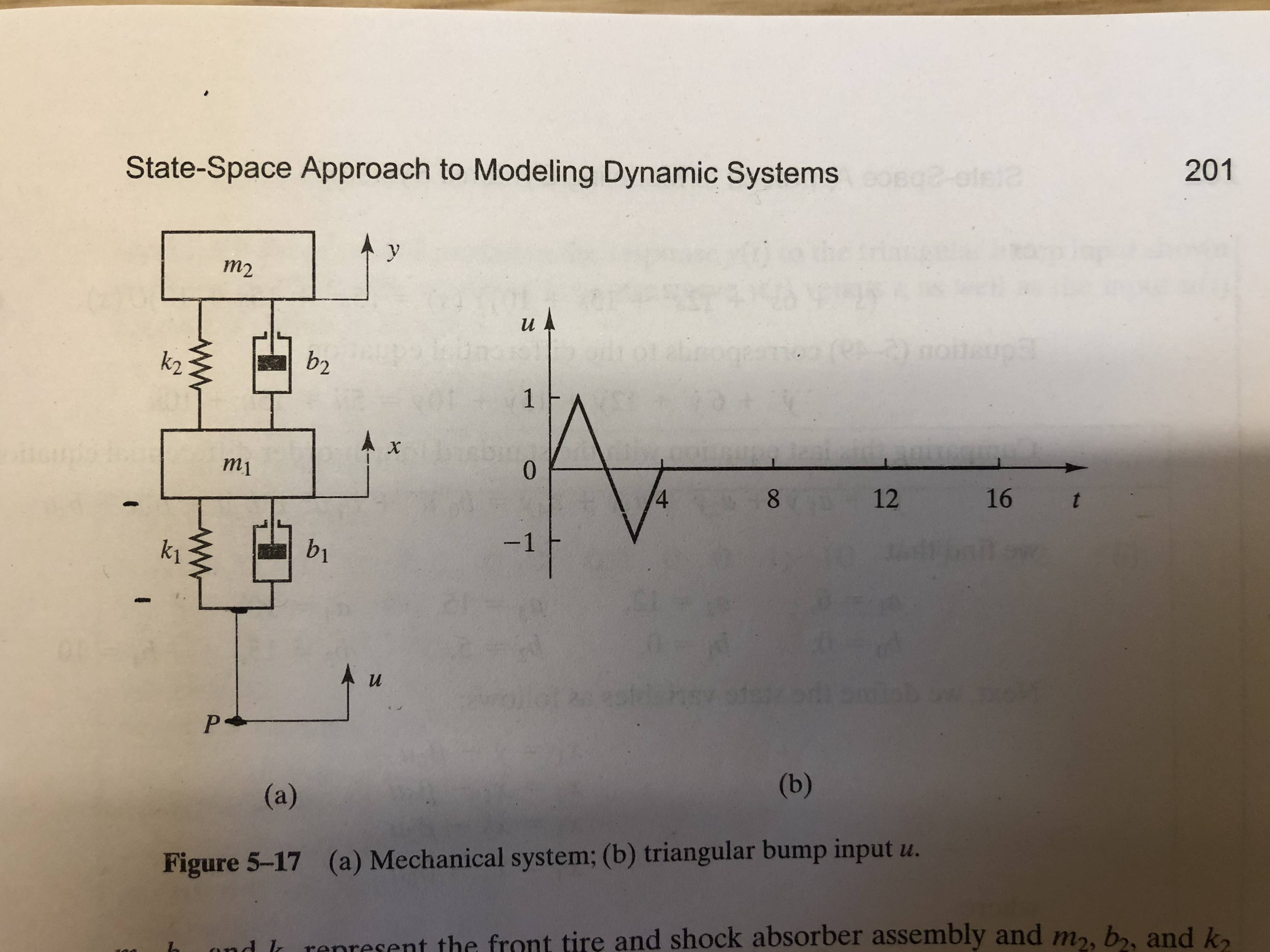Deriving the system dynamics is systematically done using free-body diagrams, one diagram per body:

The sign of spring and damper forces are easily determined by considering the motion of one state variable at a time. For example, the spring $k_2$ will push on the mass $m_2$ if $x>0$ while $y$ is held fixed and it will pull on the mass $m_2$ if $y>0$ while $x$ is held fixed.
Hence, relative to $m_2$, that spring force will be $F_{k_2}=k_2(x-y)$ in the positive $y$-direction.
Furthermore, all force elements that connects two bodies, acting in a given direction on one body, will act with equal magnitude in the opposite direction on the other body.
The equations of motion can be written
$$\begin{align}m_1\ddot{x}&=F_{k_1}+F_{b_1}-F_{k_2}-F_{b_2}-m_1g\\
&=k_1(u-x)+b_1(\dot{u}-\dot{x})-k_2(x-y)-b_2(\dot{x}-\dot{y})-m_1g\\ \\ m_2\ddot{y}&=F_{k_2}+F_{b_2}-m_2g\\
&=k_2(x-y)+b_2(\dot{x}-\dot{y})-m_2g \end{align}$$
In state-space form, using state vector, $\mathbf{x}=\begin{bmatrix}x&y&\dot{x}&\dot{y}\end{bmatrix}^T$ and input vector, $\mathbf{u}=\begin{bmatrix}u&\dot{u}\end{bmatrix}^T$ we get the system
$$\dot{\mathbf{x}}=\displaystyle\begin{bmatrix}0&0&1&0 \\ 0&0&0&1 \\
\displaystyle-\frac{(k_1+k_2)}{m_1}&\displaystyle\frac{k_2}{m_1}&\displaystyle-\frac{(b_1+b_2)}{m_1}&\displaystyle\frac{b_2}{m_2}\\
\displaystyle\frac{k_2}{m_2}&\displaystyle-\frac{k_2}{m_2}&\displaystyle\frac{b_2}{m_2}&\displaystyle-\frac{b_2}{m_2}\end{bmatrix}\mathbf{x}+\begin{bmatrix}
0&0\\0&0\\\displaystyle\frac{k_1}{m_1}&\displaystyle\frac{b_1}{m_1}\\0&0\end{bmatrix}\mathbf{u}+\begin{bmatrix}0\\0\\-g\\-g\end{bmatrix}$$
If we neglect gravity we get the standard form:
$$\dot{\mathbf{x}}=\mathbf{A}\mathbf{x}+\mathbf{B}\mathbf{u}$$
The road-elevation input $u$ can be interpreted as the integral of a composite step function $\dot{u}$, where
$$\dot{u}=\begin{cases} 1 && t\in[0,1) \\ -1 && t\in[1,3)\\ 1 && t\in[3,4) \\ 0 && t \geq 4\end{cases}$$
We can test the model quickly as follows, using forward Euler integration with NumPy and Python
import numpy as np
import matplotlib.pyplot as plt
# Mass, spring and damper constants
m1,m2,k1,k2,b1,b2 = 15,100,2000,10,60,60
# Integration scheme and initial values
h = 0.01
N = int(15/h)
t = np.linspace(h,15,N)
x = np.array([[0,0,0,0]]).T
# Input signals
udot = 1 * (t <= 1) - 1 * (t > 1) + 2 * (t > 3) - 1 * (t > 4)
u = np.cumsum(udot)*h
# System matrices
A = np.array([
[0, 0, 1, 0],
[0, 0, 0, 1],
[-(k1+k2)/m1, k2/m1, -(b1+b2)/m1, b2/m1],
[k2/m2, -k2/m2, b2/m2, -b2/m2]
])
B = np.array([
[0, 0],
[0, 0],
[k1/m1, b1/m1],
[0, 0]
])
# Book-keeping lists
xs = []
ys = []
for i in range(0,N):
xdot = A @ x + B @ np.array([[u[i]], [udot[i]]])
x = x + xdot*h
xs.append(x[0,0])
ys.append(x[1,0])
fig = plt.figure()
ax1 = fig.add_subplot(211)
ax1.plot(t, u, 'c', t, udot, 'm--')
plt.xlim([0,15])
plt.legend(['u','udot'])
ax2 = fig.add_subplot(212)
ax2.plot(t, xs, t, ys)
plt.xlim([0,15])
plt.legend(['x','y'])




m1andm2are definitely needed. $\endgroup$